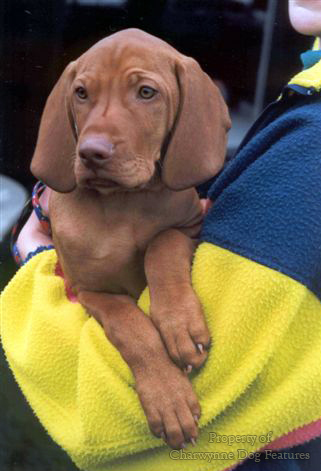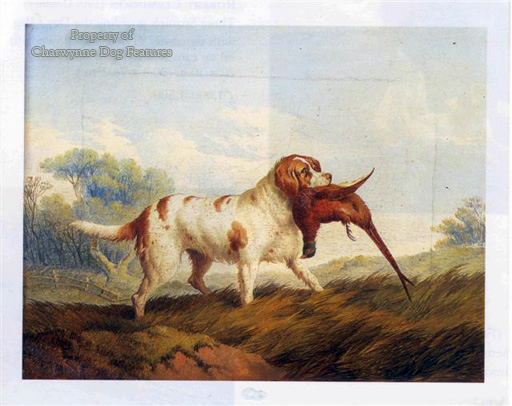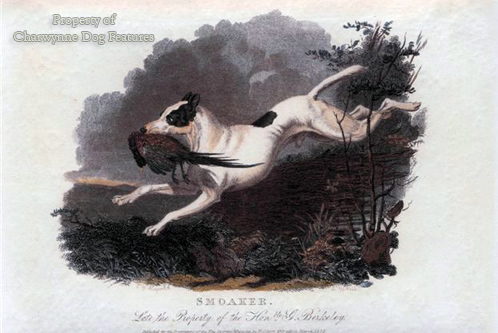175 British HPR New Gundog breed
DO WE NEED A BRITISH HPR?
by David Hancock
 Our native breeds of sporting dog were developed in response to the needs of man when hunting game. In this way, the water-dog would retrieve arrows, bolts and shot duck from ponds, the decoy dog would entice wildfowl within range of the hunter's guns, the pointing and setting breeds would indicate feathered game hiding in cover, the spaniels would flush or spring it and retrievers would pick up shot game on battue shoots.
Our native breeds of sporting dog were developed in response to the needs of man when hunting game. In this way, the water-dog would retrieve arrows, bolts and shot duck from ponds, the decoy dog would entice wildfowl within range of the hunter's guns, the pointing and setting breeds would indicate feathered game hiding in cover, the spaniels would flush or spring it and retrievers would pick up shot game on battue shoots.
New different blood was introduced into an established gundog breed in order to modify that breed to suit particular styles and methods of the sport. To style and method you could usefully add country, for the terrain, cover and going over which game is shot has played a crucial role in the development of gundog breeds. From these three considerations our specialist pointers and setters were produced, retrievers introduced and the various spaniel breeds emerged in the last century or so. So too were the "all-rounders" from mainland Europe.
The quite astonishing increase in the popularity here of the breeds which hunt, point and retrieve over the last thirty years, of which, from my own personal dislike of 'battue' shooting, I thoroughly approve, must however have some harmful effects on our native breeds. This preference for novelty breeds from abroad though is not without precedent. Four hundred years ago the much quoted Dr. Caius was writing of spaniels in England with these words:" There is also at this day among us a new kinde Brought out of Fraunce ( for we Englishe men are Marvaious greedy gaping gluttons after novelties, And covetous covrorauntes of things that be seldom, Rare, straunge, and hard to get.)".
But there is nothing rare or hard to get about gundog breeds from the Continent nowadays. The Kennel Club registrations for such breeds for 1988 reveal at a glance their current popularity: some 650 German short-haired pointers, 300 Hungarian vizslas and over 1,100 Weimaraners, quite apart from spinones, large Munsterlanders, wire-haired pointers and Brittanies. Twenty years ago the position was very different: 100 more of our pointers than GSPs, twice as many of our pointers than Weimaraners and seven times as many of them as vizslas. Now there are twice as many Weimaraners as there are English pointers. Such a trend can easily be put down to changes in shooting styles as well as cost-effectiveness. But in the last two hundred years whatever the preferred style, our gundog breeders have responded by producing native breeds to fit the bill.
In this way, the Sussex, Welsh cocker, Devon cocker, Clumber and English springer spaniels emerged to suit the needs of sportsmen in different localities, as did various strains of setter: the Earl of Seafield's, Lord Ossulton's, the Earl of Southesk's, Lord Lovat's, the Earl of Carlisle's and Lord Wallace's. The break up of many great estates and the loss of a large number of ancestral homes are often cited as the reasons for the lack of noble patronage for our native breeds today. But if you research the real history of our great houses and big estates down the centuries, such changes are entirely in keeping with previous trends not a contemporary phenomenon. I suspect that lack of noble patronage today comes from lack of interest more than anything else.
The patronage of the setter by the aristocracy can be matched in other gundog breeds too: the Clumber by the Dukes of Newcastle, the pointer by the Duke of Kingston, Lords Derby and Sefton, Sir Richard Garth and the Earl of Arran, the Labrador by the Earl of Malmesbury, the Duke of Buccleuch, the Earl of Home, Lord Knutsford and Countess Howe and the English springer by Sir Francis Boughey, Lady Portal and the Duke of Hamilton. The current scene is so very different and this to me is a most important change from one hundred years ago.
Another key element has been the almost absurd reverence for the pedigree since the advent of the conformation dog show. Nowadays the pedigree is often considered more important than the dog. I believe it is fair to say that our modern pedigree breeds evolved because of our ancestors' irreverence for the pedigree. Time and time again when you are researching a famous breed you come across outcrosses or the use of outside blood to infuse quality or certain desirable characteristics. Once a breed is stabilised it is easy to appreciate a subsequent reliance on pure breeding. But when a wider or changed function is required, then new blood is needed. The sanctity of a gene-pool in changing times is surely challengeable. A gundog should be bred to the demands of the day not those of yesterday.
I would like to see a British breeder develop a hunt, point and retrieve gundog from native stock. We have proven stock in each specialist area, is it really beyond the modern generation to produce a native all-rounder? If the noble families have failed to retain their historic interest, surely the BFSS, the BASC or a game-food/dog-food manufacturer would pick up the challenge. The Kennel Club may not recognise a new native breed very readily but they are never slow to chase more registration fees even in disputed circumstances, as the Parson Jack Russell terrier breed recognition controversy indicates.
Economic change, sporting style and the type of ground shot over have combined to contribute to the ever increasing choice of a Continental all-round gundog by British sportsmen. But if we know what we want from foreign gundogs, why not produce our own all-rounder? It would not be difficult to draw up the blueprint. By this I don't mean a description of what such a gundog should look like. I admire a handsome dog but I respect a dog for what it can do. I would be seeking a functional blueprint not a detailed list of cosmetic breed points. All breeds of sporting dog came into being for what they could do not what they might look like. 
We often overlook that, of the gundog breeds, only the retrievers were specifically developed to work with the gun. The technical advance which provided the breech-loader created the retriever. Sporting dogs worked traditionally with the falcon, the net, the bolt and the arrow and with hounds in some countries. They have had to adapt to every change, whether technical or otherwise. Our ancestors developed the best gundogs in the world, breeds valued far beyond the shooting field. Are we now saying that we can breed retrievers, setters, pointers and spaniels for the demands of times past but only the Germans, the Hungarians or the French can produce the type of dog favoured today?
Traditionalists will understandably point out the problems of foxhound blood manifesting itself in the pointer, of setter blood coming through too strongly in the flatcoat or of water-spaniel blood influencing the search pattern of the golden retriever. But this serves to play down the admirable desirable qualities passed on by these ancestor breeds. There is quite often too as wide a difference within a breed as between breeds. With a closed gene-pool in modern pedigree breeds, the most powerful genetic influences will inevitably gain the ascendancy, however gradually.
This trend can be seen in the increasingly houndlike Labrador, the greyhound look coming through in the pointer and the setter-like appearance of the show English springer. Beyond the gundog breeds this tendency is revealing itself too in other breeds: the St. Bernard increasingly displaying mastiff blood, the show collie borzoi blood, the Bedlington terrier whippet blood and the Irish wolfhound Great Dane blood. Breeding for type in a dog breed is a perpetual search not a one-time achievement.
As C.J.Davies wrote in his very informative "The Theory and Practice of Breeding to Type": "The key to success in breeding to type lies in the one point--SELECTION. Everything else is subordinate to it...Inbreeding creates nothing new. It merely ensures the perpetuation of qualities already present." Selection within a closed gene-pool would not be the best way to obtain new or varied qualities in a gundog breed. But if you select a superb retriever and a pointer which excels, once you get the blend of qualities correctly attuned, then a good pointer-retriever is within reach. The attainment of this blend is the skill of the master-breeder. There is no country in the world to rival the British record in producing high quality pedigree breeds of dog. Have we lost the skill? I don't think so, just the will.
The best all-round hunting dog I ever saw was a collie X greyhound lurcher, which could use air and ground scent superbly, react like lightning to movement yet retrieve to hand without marking the still-live game. Such a hunting dog is only bred by an informed breeder, rigorously selecting breeding stock according to inherited functional capability. Our national pride should be thoroughly dented by the growing public preference for foreign hunt, point and retrieve breeds. The demand has been there for some years; the modern sportsman ever increasingly prefers an all-rounder. As our trading deficit reveals each month, the consumer gets what he wants from abroad when we cannot produce it at home.
Over the last decade Russian geneticists have been developing a purposely designed service dog, out of dissatisfaction with what they saw as deteriorating recognised breeds. How strange that we in the free-thinking West should be too locked in dogma to do likewise. I believe that as far as the all-round gundog is concerned Britain could produce a world-beater. For an experienced knowledgeable gundog breeder this would prove a most marvellous challenge. We've had the "dropper", now we're looking for the "hunter".